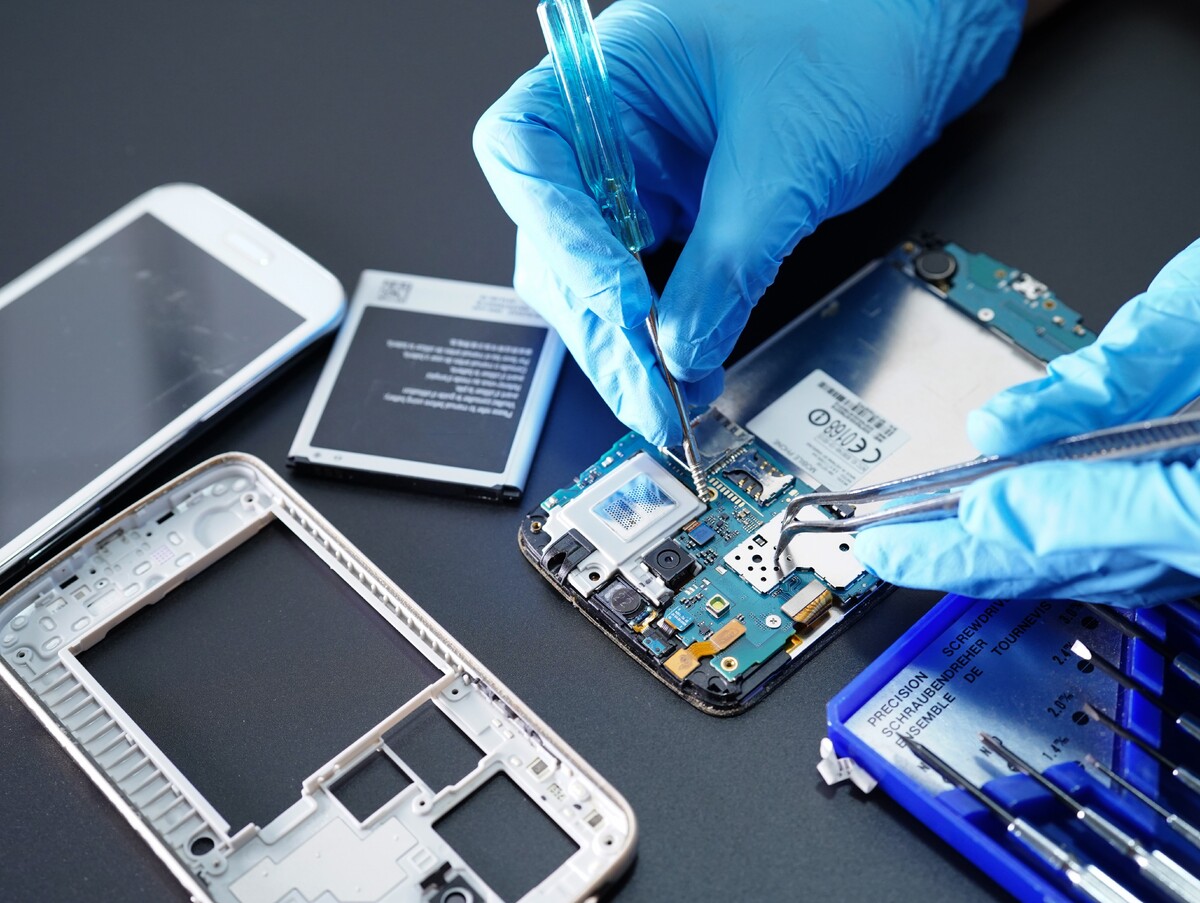How can we fix the right to repair?
As the world’s waste mountain grows, rates of resource extraction continue to rise and the cost-of-living skyrockets, how can we justify our constant demand for new products and gadgets when our old items would work fine with a bit of TLC? The problem, say right to repair advocates, is that the TLC on offer isn’t fit for purpose.

Gadgets and household appliances are designed to make our lives easier, so when they break down – often at the most inconvenient moment – it’s a real blow to our daily routine. Without a working washing machine the laundry piles up, a broken laptop means emails go unanswered, and dinner becomes a complicated chore without a functional oven or microwave. Finding a quick and easy solution is, unsurprisingly, top of the to-do list.
For most people – 75%, according to a survey by online retailer eSpares – this solution involves simply discarding the broken appliance and replacing it with a new model. While this solves the immediate household headache, it’s creating a much more serious environmental problem down the line. According to the European Commission, these discarded products – which could otherwise be repaired – lead to 35 million tonnes of waste, 30 million tonnes of resource consumption, and 261 million tonnes of greenhouse gases in the EU every year. Our appetite for ‘new’ is unsustainable.
As the conversation around resource use and the circular economy becomes louder, there’s a growing community of people fighting back against this trend, espousing repair and refurbishment as a way to keep otherwise perfectly fine appliances in use. According to Ugo Vallauri, co-director of The Restart Project, there are around 500 dedicated community repair groups in the UK alone, and more than 900 events slated for International Repair Day on 21 October, which Vallauri co-founded in 2017.
“We’re definitely seeing an increased interest in repair,” he says. “People care more and more about this for a range of reasons. It started as an environmental endeavour, but it’s increasingly a matter of cost reduction and a response to the cost-of-living crisis.” Indeed, the European Commission estimates that opting for replacement instead of repair costs European consumers around €12 billion every year.
However, he adds, there’s a wide range of systemic barriers in place that puts repair out of the reach of those that would otherwise embrace it. “Lots of things, from weak legislation to manufacturers’ pursuit of profit, means that choosing repair just isn’t viable for a lot of people.”
The current state of repair
In Europe, the Sale of Goods Directive stipulates that products must be covered by a legal guarantee, which lasts for two years. In the UK, the legal warranty lasts between 12 months and two years. During this period, if an appliance or gadget breaks down, consumers have a choice of free remedies provided by the seller and can generally choose between replacement or repair. Most opt for replacement because it’s usually quicker, or because they believe a new model will be more reliable than one that’s already needed repair. According to the Commission, “returned goods mostly end up as waste.”
After the legal guarantee has expired, many consumers are discouraged from repair because it’s difficult to identify a suitable repair service at an acceptable price, or they have uncertainty about the conditions or inconveniences linked to the process.
Indeed, a quick scan at the services offered by key retailers and manufacturers shows the extent of these barriers. UK retailer Curry’s, for example, claims to carry out more than 800,000 repairs every year and states that it’s “good friends with the UK’s largest part supplier” which means it can “fix things super fast”. However, its Care & Repair service requires an ongoing monthly subscription and can’t be used for one-off repairs. Electronics giant Sony requires proof of purchase before allowing customers to book a repair online, while Samsung’s website doesn’t reveal the cost of the repair until a booking has been made. Bosch, meanwhile, stipulates a flat fee for an engineer call-out and labour, but notes that spare parts are charged additionally. It adds that in some cases the company may use a service partner to conduct the repair on its behalf who “may charge different prices”, and that customers will only be informed of these once they’ve been contacted to arrange the repair. (Ocki reached out to these companies for comment but they either did not respond or declined to participate).
“These services aren’t transparent and they’re complicated,” says Vallauri. “So it’s no surprise that people simply choose to replace their products.”

The right to repair proposal
In a bid to remedy these challenges, the European Commission adopted a proposal for a new Directive on common rules promoting the repair of goods – the right to repair proposal. It contains a mix of actions designed to make the right to repair what Commissioner for Justice Didier Reynders calls a “reality” for consumers. “With these new measures, consumers will gain the tools they need to choose repair and make a positive contribution to the circular economy,” he says. “It will also send an important message to companies that sustainable business models and investments in repairs pay off.”
Chief among the proposed measures is an online matchmaking repair platform that will connect consumers with repairers and sellers of refurbished goods in their area, as well as a European Repair Information Form, which consumers can request from any repairer, designed to bring transparency to repair conditions and price. The proposal also includes a European quality standard for repair services, open to all repairers willing to commit to minimum quality standards.
It is estimated the initiative will save 18.5 million tonnes of GHG emissions, 1.8 million tonnes of resources, and three million tonnes of waste over 15 years.
The proposal has been widely welcomed by environmental and consumer champions, although some believe it doesn’t address the business pressures that are contributing to the overall repair challenge. Christel Delberghe, director general of EuroCommerce, says that it’s critical to create positive incentives for consumers and businesses to choose repair over other remedies. “This means, for instance, putting in place financial incentives for businesses that will create a business case for our members to offer repair, and that will encourage consumers to choose to repair,” she says. “We need systemic change and changes to mindsets and practices. This means doing more than simply providing more information to consumers, who are already overloaded, and going further than piling further obligations onto businesses.” She adds that repair should not be free of charge. “If businesses are allowed to make a reasonable profit, they will create an attractive business model for this practice.”
Right to repair models at work
The standard envisioned by both the proposal and Delberghe has already been trialled in some parts of Europe. In Austria, the Reparatur Bonus scheme – funded by the Ministry of Climate Protection – gives consumers up to €200 for the repair of an electrical item, or up to €30 to obtain a repair cost estimate. Consumers can find a participating repair provider via the scheme’s website. More than 353,000 repairs were carried out under the scheme between April and December 2022.
Other countries, meanwhile, are taking a more business-centred approach. France is financing discounted repairs through Extended Producer Responsibility (EPR) fees paid by producers, while Sweden has reduced its VAT rate on repairs from 25% to 12%. In Amsterdam, consumers can get 40% off clothing repairs as part of the area’s City Pass initiative.
According to Vallauri, these are promising initiatives that have the potential to kickstart wider action and play a critical role in getting the Right to Repair proposal over the finishing line. However, they don’t address some of the more nefarious challenges of repair.

Repair vs capitalism
“We’re seeing a lot of deliberate choices made by manufacturers that limit the feasibility of repair,” says Vallauri. “Addressing these factors will require a lot of work.”
These obstacles include things like planned obsolescence – an increasing barrier to repair in an age where all manner of products rely on external software support and updates to operate effectively. “My smartphone, for example, was only released three years ago, but the maker will no longer support its functionality as of this year,” says Vallauri. “The device itself is fine – it works fine. But there are no more updates to keep it secure. So what do I do with it?”
Design choices also play a factor. “Products are often designed in a way that means disassembly and reassembly is beyond the capacity of repair providers,” says Vallauri. “Or official parts are so expensive that replacing a screen ends up costing close to the same as buying another refurbished model.” He adds that some manufacturers are actively dissuading repair by using software to control what repairs can or cannot be performed, and are using software to monitor and restrict the use of spare parts.
“Companies can see that there is an appetite for more repairable devices, but they’re always going to try to carve as much profit as possible, so they want to maintain as much control over the repairs as they can,” says Vallauri. “This is very different from the universal right to repair that we envision and that we campaign towards. We want legislation to make repair accessible to everyone so that everyone has agency to choose between multiple options for repair.”
Slow progress
The complexity of the overall repair picture means that the advent of meaningful legislation has been slow, which does not necessarily bode well for the right to repair proposal. Nonetheless, changes are sluggishly afoot.
From 2027, for example, new rules will come into place stipulating that all consumer products that carry batteries must have batteries that can be replaced by the consumer. “Some products are touted as having a replaceable battery, but in reality that means some level of electronics expertise or the ability to use a soldering iron, which is beyond most peoples’ capabilities, so this new law will address that,” says Vallauri.
And just last month – thanks to the efforts of Vallauri and his team – a new regulation for the eco-design of smartphones and tablets was published in the Official Journal of Legislation in the EU. This means that smartphones will have to be supported for a minimum of five years from the time they’re retired from the market. This means that a broader range of spare parts will have to be available, batteries will have to degrade slower and the phones will have to be more durable to manage everyday wear and tear for longer, says Vallauri.
UK campaign to step up actionIn the UK over 100 organisations have signed a Repair and Reuse Declaration, saying that the UK is falling behind other countries in its support of repair and reuse, despite being the second highest producer of electronic waste per capita in the world. The declaration notes that repair and reuse are central to achieving a truly circular, less wasteful, economy, as well as tackling climate change, achieving net zero, reducing living costs for UK households and creating green skilled jobs. It is calling on UK government and decision makers to:
|
Mitigating new model mania
But even if business and legislation manage to align on a realistic repair model, there remains perhaps the biggest challenge of all: consumer thirst for the latest must-have device. Brands spend millions on lust-inducing marketing campaigns, designed to convince consumers that their lives could be that bit bigger and better, if only they had the right gadget to help them along. And it works. Apple – which has to date sold over 2.32 billion iPhones, made a total of 225.3 million global iPhone sales in 2022. That’s the equivalent of nearly 619,000 brand new iPhones sold every single day. So while manufacturers might make products a little more repairable, they’re still churning out new models every nine to 12 months.
But Vallauri is optimistic that the consumer demand driving this conveyor belt is on the wane. He points to a recent campaign from Extinction Rebellion, launched alongside Apple’s latest iPhone offering, for the ‘iPhone Infinity’. The parody website (and AI-generated message from a faux Tim Cook) features a modular device – not unlike that already produced by Fairphone – with the message, “You have the Right to Repair: Keep your iPhone working perfectly, as long as you want.”
“People are becoming fatigued by the constant slew of new technology and the costs involved in obtaining it,” says Vallauri. “And they’re wising up to the fact that the tide of new products entering the market is largely designed to appeal to those who need a new device because their existing model isn’t designed to last.” Put simply, he says, “Why not just make better products?”
The future of repair
The end of October will see another round of repair-related discussions take place in the European Parliament, and perhaps some clarity on the level of ambition policymakers are aiming for. “The original proposal – which focused on the legal guarantee and manufacturers providing repair services – isn’t particularly compelling,” says Vallauri. “We’re more interested in a ban on manufacturer practices that complicate the repair process.”
Whatever form it takes, it’s hard to say when the proposal will become law. “The battery legislation isn’t coming into effect until 2027, and it took a long time to get that on the table,” Vallauri notes. “However, our campaign is unique because it’s not solely focused on the environmental impacts of products, but also on consumer rights and on freedom of choice, which people are becoming more vocal about generally.”
In the meantime, Vallauri and his team – and thousands of others around the world – continue to work tirelessly to make repair an accessible and affordable reality for consumers, and not just an theoretical choice hampered by the pursuit of profit over the planet.
Find out more
|
Activate employees
Find out how OckiPro membership engages employees to deliver sustainability impact.
Get Involved
There are many ways to get involved with Ocki and its community. To find out more, click the button below




